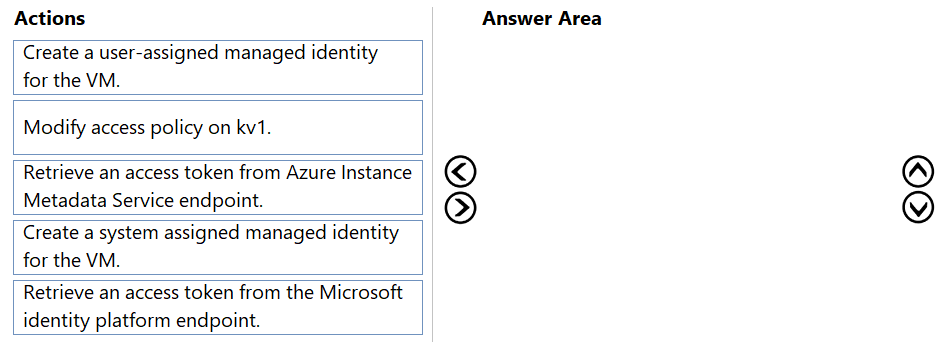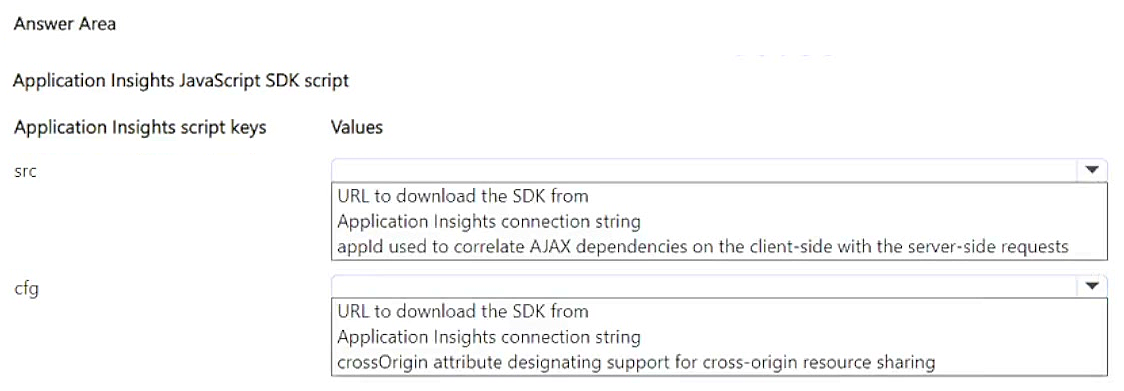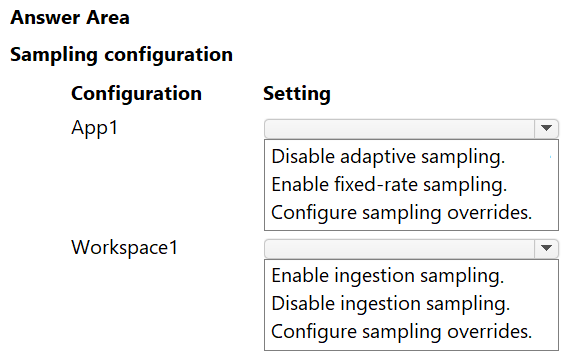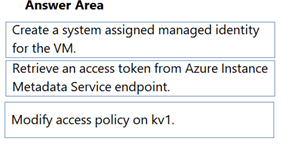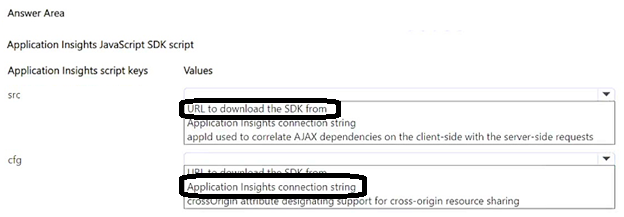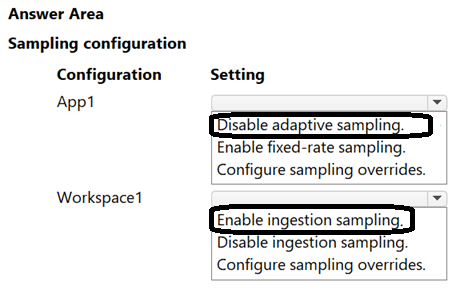Question #421
Note: This question is part of a series of questions that present the same scenario. Each question in the series contains a unique solution that might meet the stated goals. Some question sets might have more than one correct solution, while others might not have a correct solution.
After you answer a question in this section, you will NOT be able to return to it. As a result, these questions will not appear in the review screen.
You have an Azure App Service web app named WebApp1 and an Azure Functions app named Function1. WebApp1 is associated with an Application Insights instance named appinsights1.
You configure a web test and a corresponding alert for WebApp1 in appinsights1. Each alert triggers a delivery of email to your mailbox.
You need to ensure that each alert also triggers execution of Function1.
Solution: Configure an Azure Monitor Insights workbook.
Does the solution meet the goal?
Note: This question is part of a series of questions that present the same scenario. Each question in the series contains a unique solution that might meet the stated goals. Some question sets might have more than one correct solution, while others might not have a correct solution.
After you answer a question in this section, you will NOT be able to return to it. As a result, these questions will not appear in the review screen.
You have an Azure App Service web app named WebApp1 and an Azure Functions app named Function1. WebApp1 is associated with an Application Insights instance named appinsights1.
You configure a web test and a corresponding alert for WebApp1 in appinsights1. Each alert triggers a delivery of email to your mailbox.
You need to ensure that each alert also triggers execution of Function1.
Solution: Configure an Application Insights smart detection.
Does the solution meet the goal?
Note: This question is part of a series of questions that present the same scenario. Each question in the series contains a unique solution that might meet the stated goals. Some question sets might have more than one correct solution, while others might not have a correct solution.
After you answer a question in this section, you will NOT be able to return to it. As a result, these questions will not appear in the review screen.
You have an Azure App Service web app named WebApp1 and an Azure Functions app named Function1. WebApp1 is associated with an Application Insights instance named appinsights1.
You configure a web test and a corresponding alert for WebApp1 in appinsights1. Each alert triggers a delivery of email to your mailbox.
You need to ensure that each alert also triggers execution of Function1.
Solution: Configure an Azure Monitor action group.
Does the solution meet the goal?
You have a Standard tier instance of Azure Cache for Redis named redis1 configured with the default settings.
You need to configure a Maxmemory policy to increase the amount of cache available for read operations.
How should you configure the Maxmemory policy?
A
Decrease the value of maxmemory-reserved.
B
Increase the value of maxmemory-reserved.
C
Set the Maxmemory policy to noeviction.
D
Set the Maxmemory policy to volatile-lru.
Note: This question is part of a series of questions that present the same scenario. Each question in the series contains a unique solution that might meet the stated goals. Some question sets might have more than one correct solution, while others might not have a correct solution.
After you answer a question in this section, you will NOT be able to return to it. As a result, these questions will not appear in the review screen.
You have an Azure App Service web app named WebApp1 and an Azure Functions app named Function1. WebApp1 is associated with an Application Insights instance named appinsights1.
You configure a web test and a corresponding alert for WebApp1 in appinsights1. Each alert triggers a delivery of email to your mailbox.
You need to ensure that each alert also triggers execution of Function1.
Solution: Configure an Application Insights funnel.
Does the solution meet the goal?
Case study -
This is a case study. Case studies are not timed separately. You can use as much exam time as you would like to complete each case. However, there may be additional case studies and sections on this exam. You must manage your time to ensure that you are able to complete all questions included on this exam in the time provided.
To answer the questions included in a case study, you will need to reference information that is provided in the case study. Case studies might contain exhibits and other resources that provide more information about the scenario that is described in the case study. Each question is independent of the other questions in this case study.
At the end of this case study, a review screen will appear. This screen allows you to review your answers and to make changes before you move to the next section of the exam. After you begin a new section, you cannot return to this section.
To start the case study -
To display the first question in this case study, click the Next button. Use the buttons in the left pane to explore the content of the case study before you answer the questions. Clicking these buttons displays information such as business requirements, existing environment, and problem statements. When you are ready to answer a question, click the Question button to return to the question.
Background -
Fourth Coffee is a global coffeehouse chain and coffee company recognized as one of the world’s most influential coffee brands. The company is renowned for its specialty coffee beverages, including a wide range of espresso-based drinks, teas, and other beverages. Fourth Coffee operates thousands of stores worldwide.
Current environment -
The company is developing cloud-native applications hosted in Azure.
Corporate website -
The company hosts a public website located at http://www.fourthcoffee.com/. The website is used to place orders as well as view and update inventory items.
Inventory items -
In addition to its core coffee offerings, Fourth Coffee recently expanded its menu to include inventory items such as lunch items, snacks, and merchandise. Corporate team members constantly update inventory. Users can customize items. Corporate team members configure inventory items and associated images on the website.
Orders -
Associates in the store serve customized beverages and items to customers. Orders are placed on the website for pickup.
The application components process data as follows:
1. Azure Traffic Manager routes a user order request to the corporate website hosted in Azure App Service.
2. Azure Content Delivery Network serves static images and content to the user.
3. The user signs in to the application through a Microsoft Entra ID for customers tenant.
4. Users search for items and place an order on the website as item images are pulled from Azure Blob Storage.
5. Item customizations are placed in an Azure Service Bus queue message.
6. Azure Functions processes item customizations and saves the customized items to Azure Cosmos DB.
7. The website saves order details to Azure SQL Database.
8. SQL Database query results are cached in Azure Cache for Redis to improve performance.
The application consists of the following Azure services:
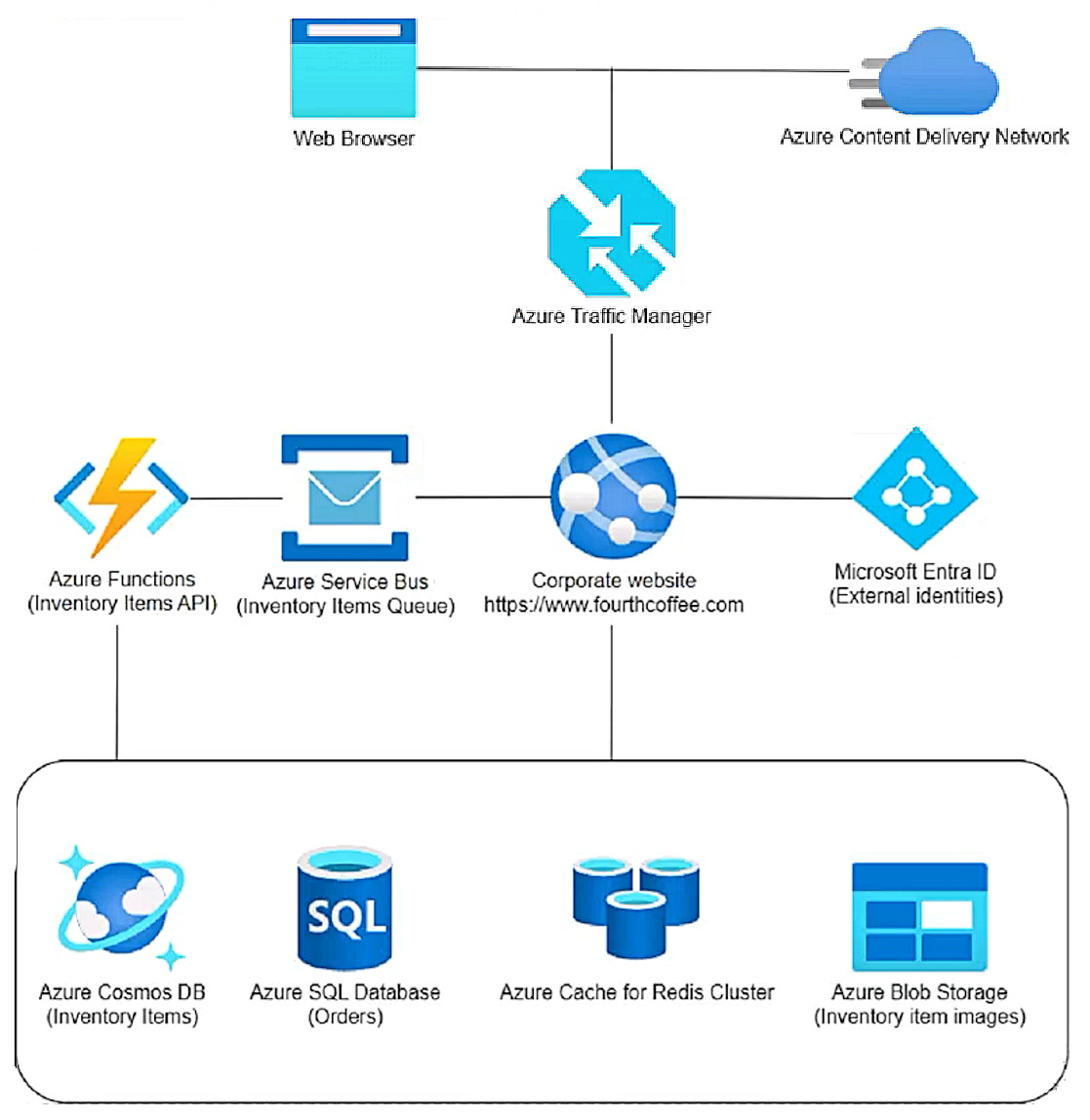
Requirements -
The application components must meet the following requirements:
• Azure Cosmos DB development must use a native API that receives the latest updates and stores data in a document format.
• Costs must be minimized for all Azure services.
• Developers must test Azure Blob Storage integrations locally before deployment to Azure. Testing must support the latest versions of the Azure Storage APIs.
Corporate website -
• User authentication and authorization must allow one-time passcode sign-in methods and social identity providers (Google or Facebook).
• Static web content must be stored closest to end users to reduce network latency.
Inventory items -
• Customized items read from Azure Cosmos DB must maximize throughput while ensuring data is accurate for the current user on the website.
• Processing of inventory item updates must automatically scale and enable updates across an entire Azure Cosmos DB container.
• Inventory items must be processed in the order they were placed in the queue.
• Inventory item images must be stored as JPEG files in their native format to include exchangeable image file format (data) stored with the blob data upon upload of the image file.
• The Inventory Items API must securely access the Azure Cosmos DB data.
Orders -
• Orders must receive inventory item changes automatically after inventory items are updated or saved.
Issues -
• Developers are storing the Azure Cosmos DB credentials in an insecure clear text manner within the Inventory Items API code.
• Production Azure Cache for Redis maintenance has negatively affected application performance.
You need to mitigate the Azure Cache for Redis issue.
What are two possible ways to achieve this goal? Each correct answer presents part of the solution.
NOTE: Each correct selection is worth one point.
A
Test application code by rebooting all nodes in the test environment.
B
Configure client connections to retry commands with exponential backoff.
C
Modify the maxmemory policy to evict the least frequently used keys out of all keys.
D
Increase the maxmemory-reserved and maxfragmentationmemory-reserved values.
E
Test application code by purging the cache in the test environment.
Case study -
This is a case study. Case studies are not timed separately. You can use as much exam time as you would like to complete each case. However, there may be additional case studies and sections on this exam. You must manage your time to ensure that you are able to complete all questions included on this exam in the time provided.
To answer the questions included in a case study, you will need to reference information that is provided in the case study. Case studies might contain exhibits and other resources that provide more information about the scenario that is described in the case study. Each question is independent of the other questions in this case study.
At the end of this case study, a review screen will appear. This screen allows you to review your answers and to make changes before you move to the next section of the exam. After you begin a new section, you cannot return to this section.
To start the case study -
To display the first question in this case study, click the Next button. Use the buttons in the left pane to explore the content of the case study before you answer the questions. Clicking these buttons displays information such as business requirements, existing environment, and problem statements. When you are ready to answer a question, click the Question button to return to the question.
Background -
Fourth Coffee is a global coffeehouse chain and coffee company recognized as one of the world’s most influential coffee brands. The company is renowned for its specialty coffee beverages, including a wide range of espresso-based drinks, teas, and other beverages. Fourth Coffee operates thousands of stores worldwide.
Current environment -
The company is developing cloud-native applications hosted in Azure.
Corporate website -
The company hosts a public website located at http://www.fourthcoffee.com/. The website is used to place orders as well as view and update inventory items.
Inventory items -
In addition to its core coffee offerings, Fourth Coffee recently expanded its menu to include inventory items such as lunch items, snacks, and merchandise. Corporate team members constantly update inventory. Users can customize items. Corporate team members configure inventory items and associated images on the website.
Orders -
Associates in the store serve customized beverages and items to customers. Orders are placed on the website for pickup.
The application components process data as follows:
1. Azure Traffic Manager routes a user order request to the corporate website hosted in Azure App Service.
2. Azure Content Delivery Network serves static images and content to the user.
3. The user signs in to the application through a Microsoft Entra ID for customers tenant.
4. Users search for items and place an order on the website as item images are pulled from Azure Blob Storage.
5. Item customizations are placed in an Azure Service Bus queue message.
6. Azure Functions processes item customizations and saves the customized items to Azure Cosmos DB.
7. The website saves order details to Azure SQL Database.
8. SQL Database query results are cached in Azure Cache for Redis to improve performance.
The application consists of the following Azure services:
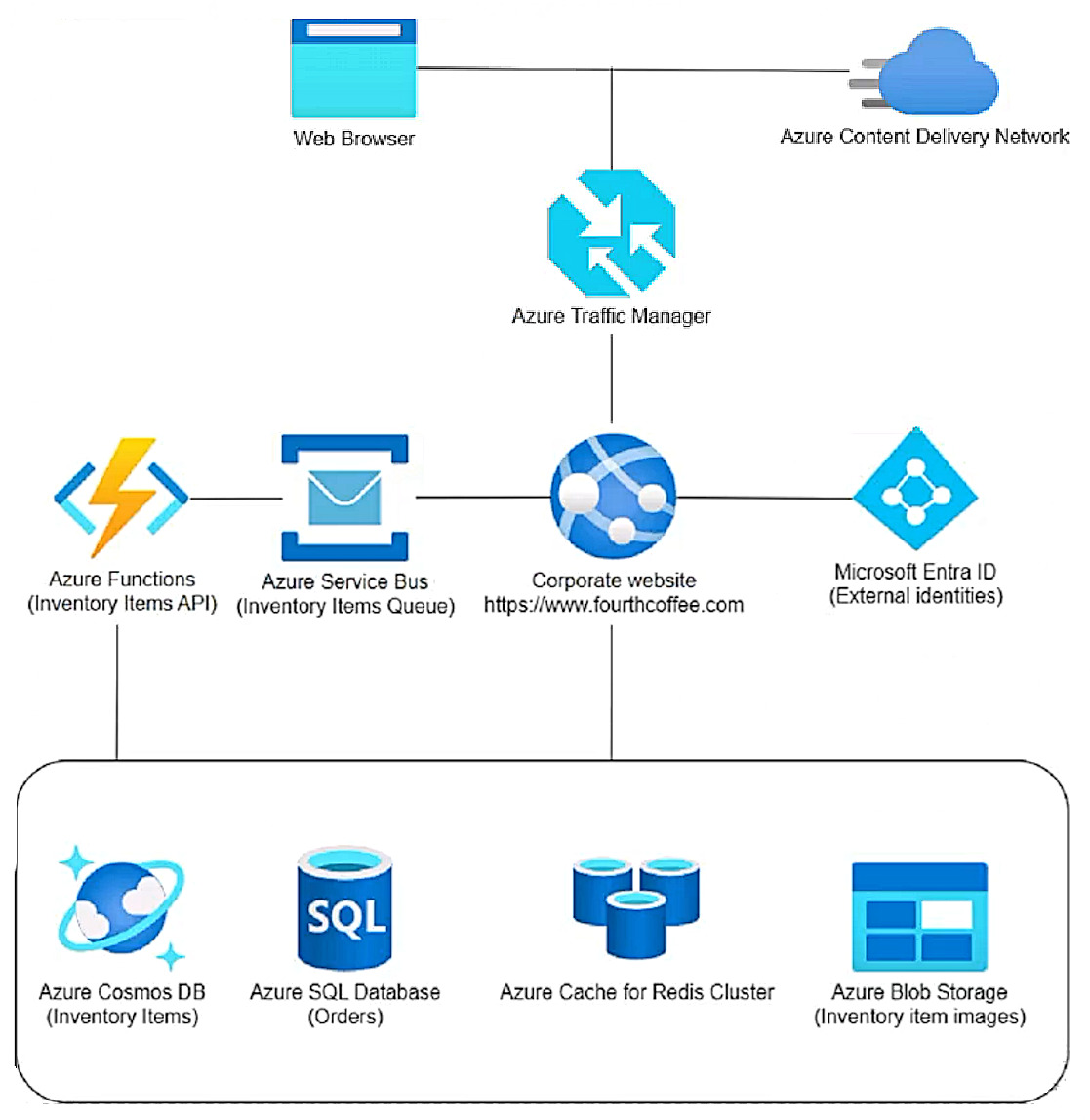
Requirements -
The application components must meet the following requirements:
• Azure Cosmos DB development must use a native API that receives the latest updates and stores data in a document format.
• Costs must be minimized for all Azure services.
• Developers must test Azure Blob Storage integrations locally before deployment to Azure. Testing must support the latest versions of the Azure Storage APIs.
Corporate website -
• User authentication and authorization must allow one-time passcode sign-in methods and social identity providers (Google or Facebook).
• Static web content must be stored closest to end users to reduce network latency.
Inventory items -
• Customized items read from Azure Cosmos DB must maximize throughput while ensuring data is accurate for the current user on the website.
• Processing of inventory item updates must automatically scale and enable updates across an entire Azure Cosmos DB container.
• Inventory items must be processed in the order they were placed in the queue.
• Inventory item images must be stored as JPEG files in their native format to include exchangeable image file format (data) stored with the blob data upon upload of the image file.
• The Inventory Items API must securely access the Azure Cosmos DB data.
Orders -
• Orders must receive inventory item changes automatically after inventory items are updated or saved.
Issues -
• Developers are storing the Azure Cosmos DB credentials in an insecure clear text manner within the Inventory Items API code.
• Production Azure Cache for Redis maintenance has negatively affected application performance.
You need to serve static content from the corporate website.
What are two possible ways to achieve this goal? Each correct answer presents a complete solution.
NOTE: Each correct selection is worth one point.
A
Store all static content in Azure Blob Storage. Enable Azure Content Delivery Network for the storage account.
B
Configure App Service networking to create a Content Delivery Network profile and endpoint.
C
Configure the Azure App Service Local Cache feature and set the app setting WEBSITE_LOCAL_CACHE_SIZEINMB value.
D
Create a nested Azure Traffic Manager profile. Configure the parent profile to the performance traffic routing method and the child profile to the priority traffic routing method.
E
Update the Azure Traffic Manager routing method to priority.
You develop an ASP. Net Care application by integrating the Application Insights SDK into your solution.
The application sends a very high rate of telemetry in a short time interval. You observe a reduced number of events, traces, and metrics being recorded and increased error rates for telemetry ingestion. Telemetry data must synchronize the client and server information to allow HTTP request and response correlation.
You need to reduce telemetry traffic, data costs, and storage costs while preserving a statistically correct analysis of application telemetry data.
What should you do?
A
Set a daily cap on the Log Analytics workspace. Create an Activity log alert rule.
B
Modify the pricing tier for the Log Analytics workspace.
C
Update the application code to reduce the number of DiagnosticSource events. Use filtering to exclude these events.
D
Disable adaptive sampling. Enable and configure the fixed-rate sampling module.
Case study -
This is a case study. Case studies are not timed separately. You can use as much exam time as you would like to complete each case. However, there may be additional case studies and sections on this exam. You must manage your time to ensure that you are able to complete all questions included on this exam in the time provided.
To answer the questions included in a case study, you will need to reference information that is provided in the case study. Case studies might contain exhibits and other resources that provide more information about the scenario that is described in the case study. Each question is independent of the other questions in this case study.
At the end of this case study, a review screen will appear. This screen allows you to review your answers and to make changes before you move to the next section of the exam. After you begin a new section, you cannot return to this section.
To start the case study -
To display the first question in this case study, click the Next button. Use the buttons in the left pane to explore the content of the case study before you answer the questions. Clicking these buttons displays information such as business requirements, existing environment, and problem statements. When you are ready to answer a question, click the Question button to return to the question.
Background -
Fourth Coffee is a global coffeehouse chain and coffee company recognized as one of the world’s most influential coffee brands. The company is renowned for its specialty coffee beverages, including a wide range of espresso-based drinks, teas, and other beverages. Fourth Coffee operates thousands of stores worldwide.
Current environment -
The company is developing cloud-native applications hosted in Azure.
Corporate website -
The company hosts a public website located at http://www.fourthcoffee.com/. The website is used to place orders as well as view and update inventory items.
Inventory items -
In addition to its core coffee offerings, Fourth Coffee recently expanded its menu to include inventory items such as lunch items, snacks, and merchandise. Corporate team members constantly update inventory. Users can customize items. Corporate team members configure inventory items and associated images on the website.
Orders -
Associates in the store serve customized beverages and items to customers. Orders are placed on the website for pickup.
The application components process data as follows:
1. Azure Traffic Manager routes a user order request to the corporate website hosted in Azure App Service.
2. Azure Content Delivery Network serves static images and content to the user.
3. The user signs in to the application through a Microsoft Entra ID for customers tenant.
4. Users search for items and place an order on the website as item images are pulled from Azure Blob Storage.
5. Item customizations are placed in an Azure Service Bus queue message.
6. Azure Functions processes item customizations and saves the customized items to Azure Cosmos DB.
7. The website saves order details to Azure SQL Database.
8. SQL Database query results are cached in Azure Cache for Redis to improve performance.
The application consists of the following Azure services:
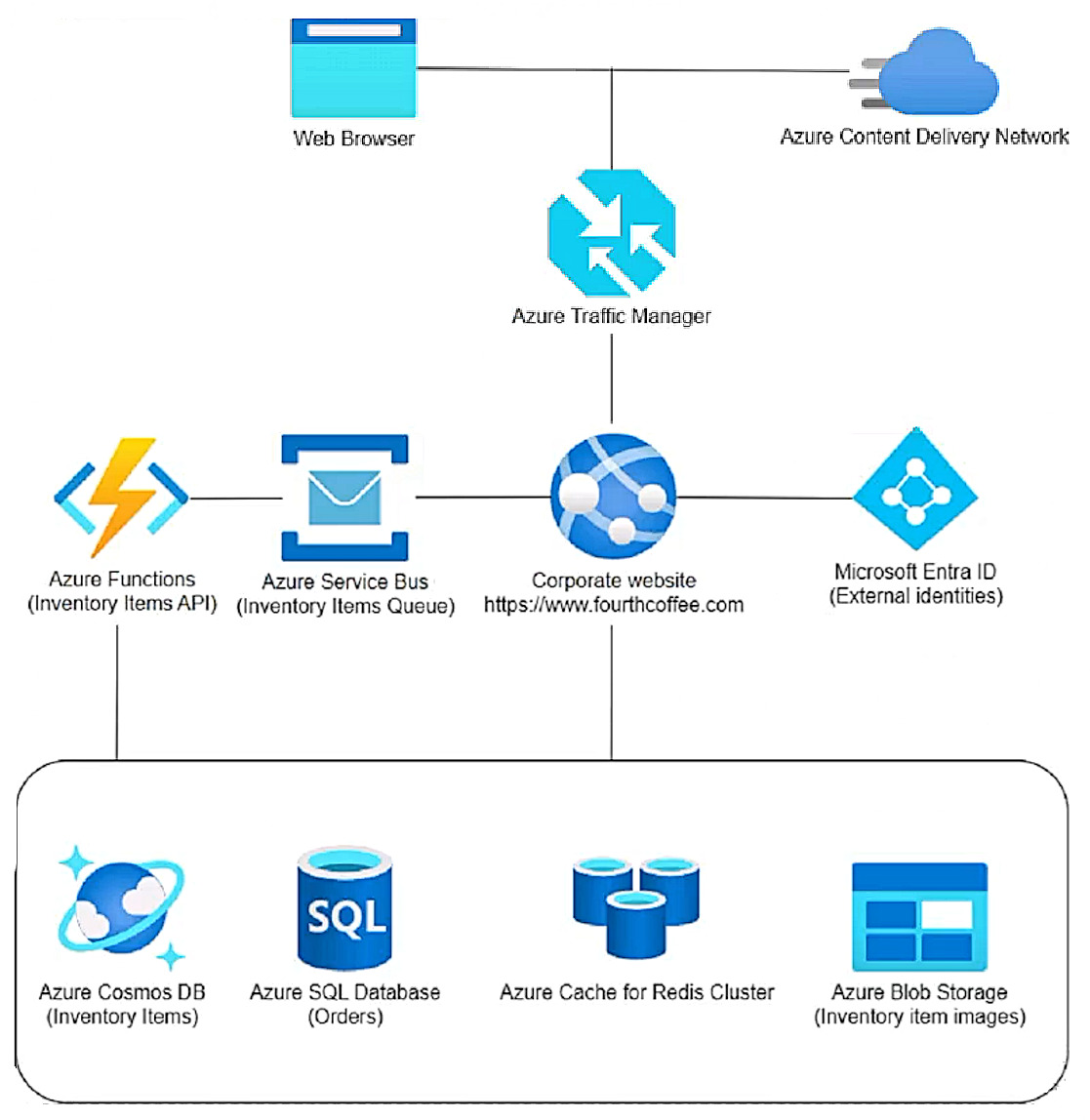
Requirements -
The application components must meet the following requirements:
• Azure Cosmos DB development must use a native API that receives the latest updates and stores data in a document format.
• Costs must be minimized for all Azure services.
• Developers must test Azure Blob Storage integrations locally before deployment to Azure. Testing must support the latest versions of the Azure Storage APIs.
Corporate website -
• User authentication and authorization must allow one-time passcode sign-in methods and social identity providers (Google or Facebook).
• Static web content must be stored closest to end users to reduce network latency.
Inventory items -
• Customized items read from Azure Cosmos DB must maximize throughput while ensuring data is accurate for the current user on the website.
• Processing of inventory item updates must automatically scale and enable updates across an entire Azure Cosmos DB container.
• Inventory items must be processed in the order they were placed in the queue.
• Inventory item images must be stored as JPEG files in their native format to include exchangeable image file format (data) stored with the blob data upon upload of the image file.
• The Inventory Items API must securely access the Azure Cosmos DB data.
Orders -
• Orders must receive inventory item changes automatically after inventory items are updated or saved.
Issues -
• Developers are storing the Azure Cosmos DB credentials in an insecure clear text manner within the Inventory Items API code.
• Production Azure Cache for Redis maintenance has negatively affected application performance.
You need to implement the processing of enqueue inventory items.
Which message value should you use?
A
Sequence number
B
Timestamp
C
Session identifier
D
Partition key
HOTSPOT
-
Case study
-
This is a case study. Case studies are not timed separately. You can use as much exam time as you would like to complete each case. However, there may be additional case studies and sections on this exam. You must manage your time to ensure that you are able to complete all questions included on this exam in the time provided.
To answer the questions included in a case study, you will need to reference information that is provided in the case study. Case studies might contain exhibits and other resources that provide more information about the scenario that is described in the case study. Each question is independent of the other questions in this case study.
At the end of this case study, a review screen will appear. This screen allows you to review your answers and to make changes before you move to the next section of the exam. After you begin a new section, you cannot return to this section.
To start the case study
-
To display the first question in this case study, click the Next button. Use the buttons in the left pane to explore the content of the case study before you answer the questions. Clicking these buttons displays information such as business requirements, existing environment, and problem statements. When you are ready to answer a question, click the Question button to return to the question.
Background
-
Fourth Coffee is a global coffeehouse chain and coffee company recognized as one of the world’s most influential coffee brands. The company is renowned for its specialty coffee beverages, including a wide range of espresso-based drinks, teas, and other beverages. Fourth Coffee operates thousands of stores worldwide.
Current environment
-
The company is developing cloud-native applications hosted in Azure.
Corporate website
-
The company hosts a public website located at http://www.fourthcoffee.com/. The website is used to place orders as well as view and update inventory items.
Inventory items
-
In addition to its core coffee offerings, Fourth Coffee recently expanded its menu to include inventory items such as lunch items, snacks, and merchandise. Corporate team members constantly update inventory. Users can customize items. Corporate team members configure inventory items and associated images on the website.
Orders
-
Associates in the store serve customized beverages and items to customers. Orders are placed on the website for pickup.
The application components process data as follows:
1. Azure Traffic Manager routes a user order request to the corporate website hosted in Azure App Service.
2. Azure Content Delivery Network serves static images and content to the user.
3. The user signs in to the application through a Microsoft Entra ID for customers tenant.
4. Users search for items and place an order on the website as item images are pulled from Azure Blob Storage.
5. Item customizations are placed in an Azure Service Bus queue message.
6. Azure Functions processes item customizations and saves the customized items to Azure Cosmos DB.
7. The website saves order details to Azure SQL Database.
8. SQL Database query results are cached in Azure Cache for Redis to improve performance.
The application consists of the following Azure services:
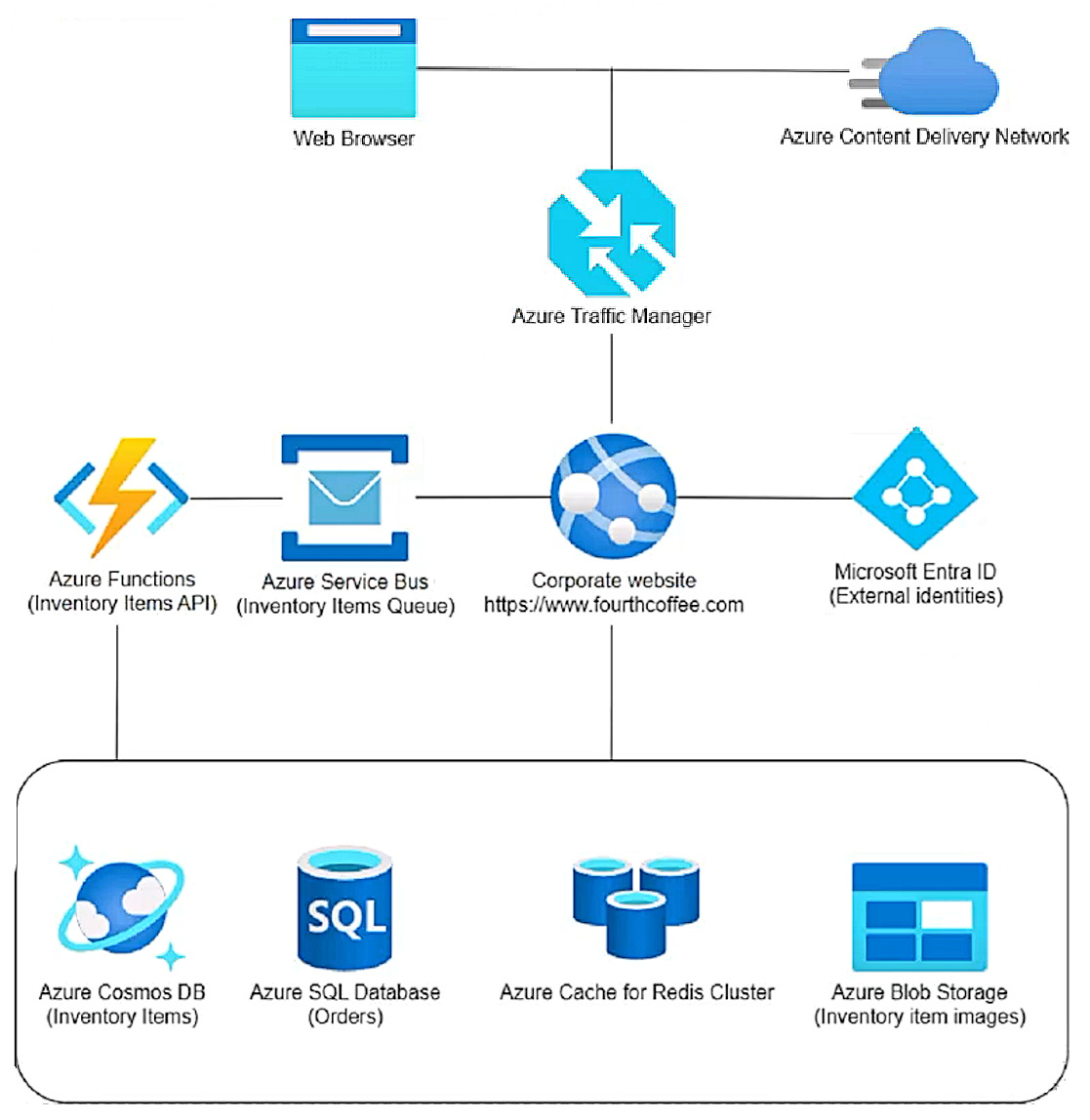
Requirements
-
The application components must meet the following requirements:
• Azure Cosmos DB development must use a native API that receives the latest updates and stores data in a document format.
• Costs must be minimized for all Azure services.
• Developers must test Azure Blob Storage integrations locally before deployment to Azure. Testing must support the latest versions of the Azure Storage APIs.
Corporate website
-
• User authentication and authorization must allow one-time passcode sign-in methods and social identity providers (Google or Facebook).
• Static web content must be stored closest to end users to reduce network latency.
Inventory items
-
• Customized items read from Azure Cosmos DB must maximize throughput while ensuring data is accurate for the current user on the website.
• Processing of inventory item updates must automatically scale and enable updates across an entire Azure Cosmos DB container.
• Inventory items must be processed in the order they were placed in the queue.
• Inventory item images must be stored as JPEG files in their native format to include exchangeable image file format (data) stored with the blob data upon upload of the image file.
• The Inventory Items API must securely access the Azure Cosmos DB data.
Orders
-
• Orders must receive inventory item changes automatically after inventory items are updated or saved.
Issues
-
• Developers are storing the Azure Cosmos DB credentials in an insecure clear text manner within the Inventory Items API code.
• Production Azure Cache for Redis maintenance has negatively affected application performance.
You need to implement a function by using Azure Functions to process customized items.
How should you implement the function? To answer, select the appropriate options in the answer area.
NOTE: Each correct selection is worth one point.
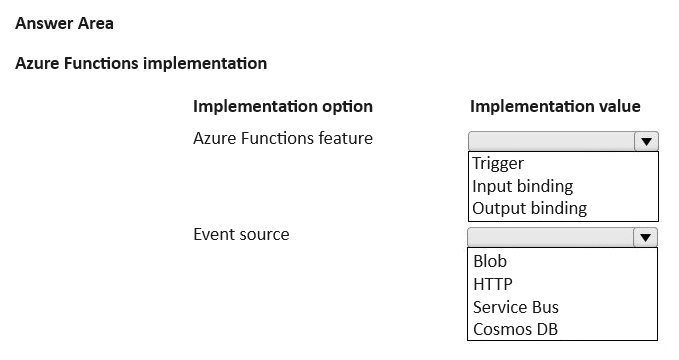
Correct Answer: 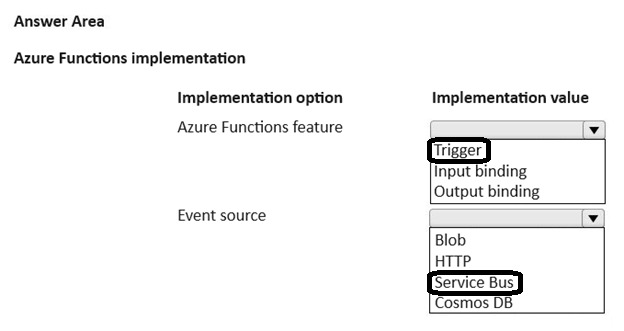
HOTSPOT
-
You plan to implement an Azure function named Function1 that will use the timer trigger.
You plan to use a TimeSpan value to set the schedule of function execution.
You need to select the hosting model and the schedule expression assignment method.
Which hosting model and schedule expression assignment method should you use? To answer, select the appropriate options in the answer area.
NOTE: Each correct selection is worth one point.
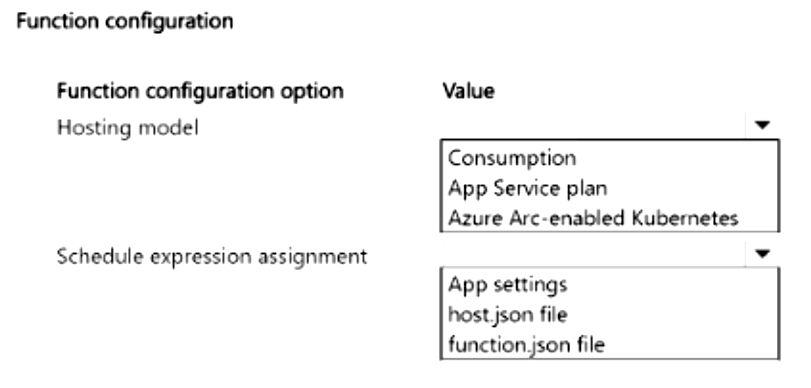
Correct Answer: 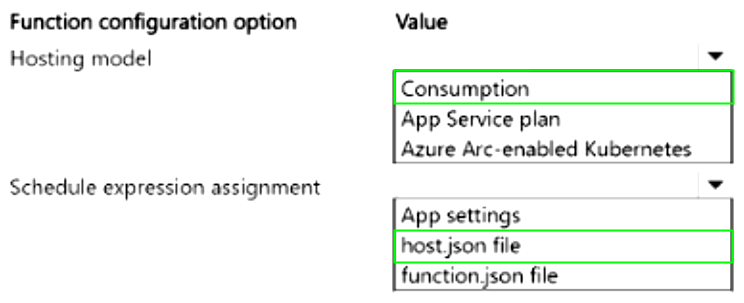
HOTSPOT
-
You are developing a microservices-based application that uses Azure Container Apps. The application consists of several containerized services that handle tasks, such as processing orders, managing inventory, and generating reports.
You must secure the container apps. All apps must reside in the same virtual network, share the same Dapr configuration, and share the same logging location.
Apps must support the configuration of the amount of memory and compute resources available to containers.
You need to configure the Azure Container App.
How should you complete the CLI command? To answer, select the appropriate options in the answer area.
NOTE: Each correct selection is worth one point.
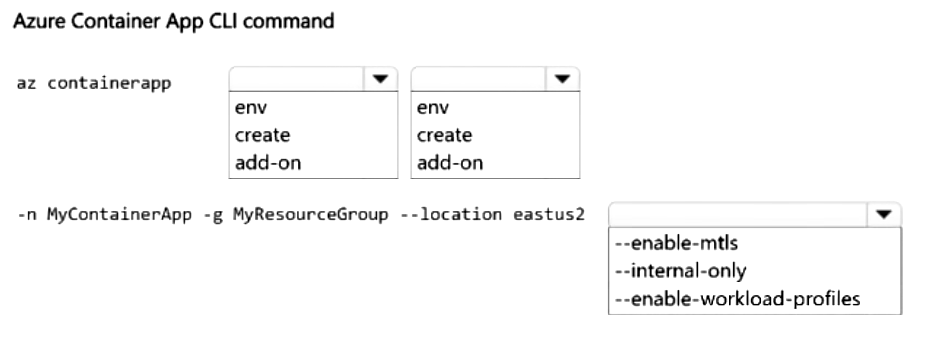
Correct Answer: 
DRAG DROP
-
You have a static website hosted in an Azure Storage account named storage1. You access the website by using a URL that ends with the web.core.windows.net suffix.
You plan to configure the website to be accessible through the URL www.contoso.com. The website must be accessible during configuration.
The contoso.com zone is hosted in Azure DNS.
You need to complete the website configuration.
Which four actions should you perform in sequence? To answer, move the appropriate domain name configuration steps from the list of domain name configuration steps to the answer area and arrange them in the correct order.

Correct Answer: 
You have an Azure Queue Storage account that contains a queue named queue1.
You plan to use Azure SDK for .NET to develop a solution that uses queue1.
You need to author C# code that will return an approximate number of messages in queue1. Your solution must minimize the development effort.
Which method should you use in your code?
A
GetProperties method of the QueueClient class
B
GetProperties method of the QueueServiceClient class
C
PeekMessages method of the QueueClient class
D
GetStatistics method of the QueueServiceClient class
You manage an Azure Storage account named storage1.
You plan to load 1 million blobs into storage1.
You must assign key-value pairs to blobs so that both keys and their values are automatically indexed and searchable by using the built-in services of storage1.
You need to run the command to assign key-value pairs.
Which command should you run?
A
Update -AzStorageBobServiceProperty
B
Set-AzStorageBlobTag
C
az storage blob service-properties update
D
Set-AzStorageBlobContent
Case study -
This is a case study. Case studies are not timed separately. You can use as much exam time as you would like to complete each case. However, there may be additional case studies and sections on this exam. You must manage your time to ensure that you are able to complete all questions included on this exam in the time provided.
To answer the questions included in a case study, you will need to reference information that is provided in the case study. Case studies might contain exhibits and other resources that provide more information about the scenario that is described in the case study. Each question is independent of the other questions in this case study.
At the end of this case study, a review screen will appear. This screen allows you to review your answers and to make changes before you move to the next section of the exam. After you begin a new section, you cannot return to this section.
To start the case study -
To display the first question in this case study, click the Next button. Use the buttons in the left pane to explore the content of the case study before you answer the questions. Clicking these buttons displays information such as business requirements, existing environment, and problem statements. When you are ready to answer a question, click the Question button to return to the question.
Background -
Fourth Coffee is a global coffeehouse chain and coffee company recognized as one of the world’s most influential coffee brands. The company is renowned for its specialty coffee beverages, including a wide range of espresso-based drinks, teas, and other beverages. Fourth Coffee operates thousands of stores worldwide.
Current environment -
The company is developing cloud-native applications hosted in Azure.
Corporate website -
The company hosts a public website located at http://www.fourthcoffee.com/. The website is used to place orders as well as view and update inventory items.
Inventory items -
In addition to its core coffee offerings, Fourth Coffee recently expanded its menu to include inventory items such as lunch items, snacks, and merchandise. Corporate team members constantly update inventory. Users can customize items. Corporate team members configure inventory items and associated images on the website.
Orders -
Associates in the store serve customized beverages and items to customers. Orders are placed on the website for pickup.
The application components process data as follows:
1. Azure Traffic Manager routes a user order request to the corporate website hosted in Azure App Service.
2. Azure Content Delivery Network serves static images and content to the user.
3. The user signs in to the application through a Microsoft Entra ID for customers tenant.
4. Users search for items and place an order on the website as item images are pulled from Azure Blob Storage.
5. Item customizations are placed in an Azure Service Bus queue message.
6. Azure Functions processes item customizations and saves the customized items to Azure Cosmos DB.
7. The website saves order details to Azure SQL Database.
8. SQL Database query results are cached in Azure Cache for Redis to improve performance.
The application consists of the following Azure services:
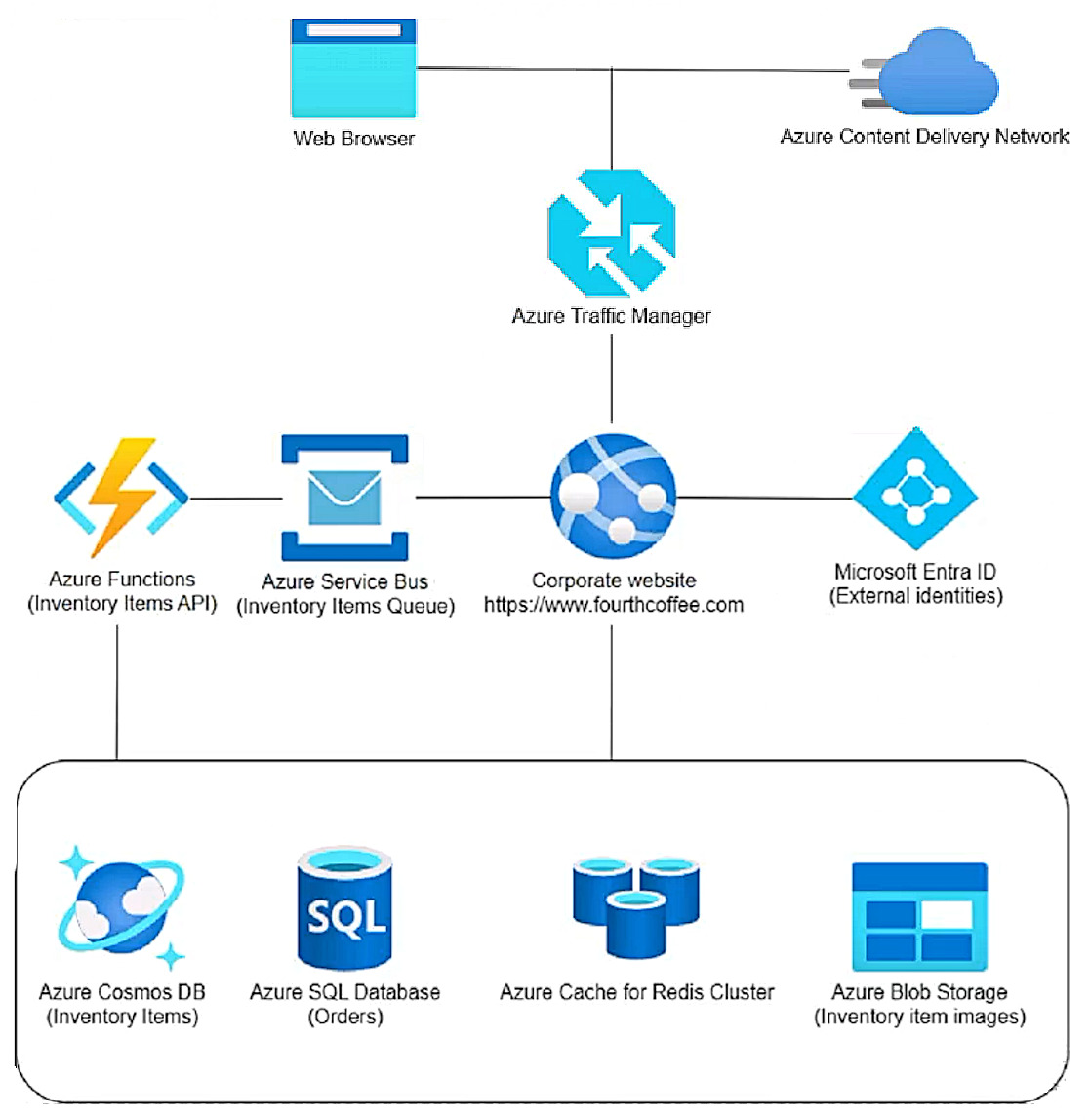
Requirements -
The application components must meet the following requirements:
• Azure Cosmos DB development must use a native API that receives the latest updates and stores data in a document format.
• Costs must be minimized for all Azure services.
• Developers must test Azure Blob Storage integrations locally before deployment to Azure. Testing must support the latest versions of the Azure Storage APIs.
Corporate website -
• User authentication and authorization must allow one-time passcode sign-in methods and social identity providers (Google or Facebook).
• Static web content must be stored closest to end users to reduce network latency.
Inventory items -
• Customized items read from Azure Cosmos DB must maximize throughput while ensuring data is accurate for the current user on the website.
• Processing of inventory item updates must automatically scale and enable updates across an entire Azure Cosmos DB container.
• Inventory items must be processed in the order they were placed in the queue.
• Inventory item images must be stored as JPEG files in their native format to include exchangeable image file format (data) stored with the blob data upon upload of the image file.
• The Inventory Items API must securely access the Azure Cosmos DB data.
Orders -
• Orders must receive inventory item changes automatically after inventory items are updated or saved.
Issues -
• Developers are storing the Azure Cosmos DB credentials in an insecure clear text manner within the Inventory Items API code.
• Production Azure Cache for Redis maintenance has negatively affected application performance.
You need to securely access inventory items when developing the Inventory Items API.
What are three possible ways to achieve this goal? Each correct answer presents a complete solution.
NOTE: Each correct selection is worth one point.
A
Create a SQL role definition under the Azure Cosmos DB account.
Create a user-assigned managed identity and assign the identity to the function app.
Assign the user assigned managed identity the SQL role definition.
Update the function app code to implement the DefaultAzureCredential class and reference the user-assigned managed identity.
B
Create a SQL role definition under the Azure Cosmas DB account.
Assign the role to the function apps system-assigned managed identity.
Programmatically access the Azure Cosmos DB keys from the function app.
C
Create a custom Microsoft Entra role.
Assign the custom roe to the Azure Cosmos DB account
Update the function app to use certificate-based authentication.
D
Create a custom Microsoft Entra role.
Assign the custom role to Azure Key Vault.
Assign the custom role to the function app.
Reference the custom role in the function app code when accessing Azure Key Vault values.
E
Create a system-assigned managed ident for the function app with read access to secrets in Azure Key Vault.
Store the Azure Cosmos DB primary key and UR in Azure Key Vaults secrets.
Use function app settings to reference the secret values.
You manage an Azure Key Vault named kv1 of Standard SKU.
You plan to programmatically store in kv1 an asymmetric key pair and use the key pair for encryption and decryption.
You must develop an application named app1 that will access the key pair in kv1.
You need to configure an object to retrieve a key pair from kv1.
Which object should you use?
A
SecretClient
B
KeyVaultSettingsClient
C
CertificateClient
D
KeyClient
You develop an ASP. Net Care application by integrating the Application Insights SDK into your solution.
The application sends a very high rate of telemetry in a short time interval. You observe a reduced number of events, traces, and metrics being recorded and increased error rates for telemetry ingestion. Telemetry data must synchronize the client and server information to allow HTTP request and response correlation.
You need to reduce telemetry traffic, data costs, and storage costs while preserving a statistically correct analysis of application telemetry data.
What should you do?
A
Set a daily cap on the Log Analytics workspace. Create an Activity log alert rule.
B
Modify the pricing tier for the Log Analytics workspace.
C
Verify adaptive sampling is enabled. Set the maxTelemetryItemsPerSecond value.
D
Set retention and archive policies by table in the Log Analytics workspace. Purge retained data beyond 30 days.
HOTSPOT
-
Case study
-
This is a case study. Case studies are not timed separately. You can use as much exam time as you would like to complete each case. However, there may be additional case studies and sections on this exam. You must manage your time to ensure that you are able to complete all questions included on this exam in the time provided.
To answer the questions included in a case study, you will need to reference information that is provided in the case study. Case studies might contain exhibits and other resources that provide more information about the scenario that is described in the case study. Each question is independent of the other questions in this case study.
At the end of this case study, a review screen will appear. This screen allows you to review your answers and to make changes before you move to the next section of the exam. After you begin a new section, you cannot return to this section.
To start the case study
-
To display the first question in this case study, click the Next button. Use the buttons in the left pane to explore the content of the case study before you answer the questions. Clicking these buttons displays information such as business requirements, existing environment, and problem statements. When you are ready to answer a question, click the Question button to return to the question.
Background
-
Fourth Coffee is a global coffeehouse chain and coffee company recognized as one of the world’s most influential coffee brands. The company is renowned for its specialty coffee beverages, including a wide range of espresso-based drinks, teas, and other beverages. Fourth Coffee operates thousands of stores worldwide.
Current environment
-
The company is developing cloud-native applications hosted in Azure.
Corporate website
-
The company hosts a public website located at http://www.fourthcoffee.com/. The website is used to place orders as well as view and update inventory items.
Inventory items
-
In addition to its core coffee offerings, Fourth Coffee recently expanded its menu to include inventory items such as lunch items, snacks, and merchandise. Corporate team members constantly update inventory. Users can customize items. Corporate team members configure inventory items and associated images on the website.
Orders
-
Associates in the store serve customized beverages and items to customers. Orders are placed on the website for pickup.
The application components process data as follows:
1. Azure Traffic Manager routes a user order request to the corporate website hosted in Azure App Service.
2. Azure Content Delivery Network serves static images and content to the user.
3. The user signs in to the application through a Microsoft Entra ID for customers tenant.
4. Users search for items and place an order on the website as item images are pulled from Azure Blob Storage.
5. Item customizations are placed in an Azure Service Bus queue message.
6. Azure Functions processes item customizations and saves the customized items to Azure Cosmos DB.
7. The website saves order details to Azure SQL Database.
8. SQL Database query results are cached in Azure Cache for Redis to improve performance.
The application consists of the following Azure services:
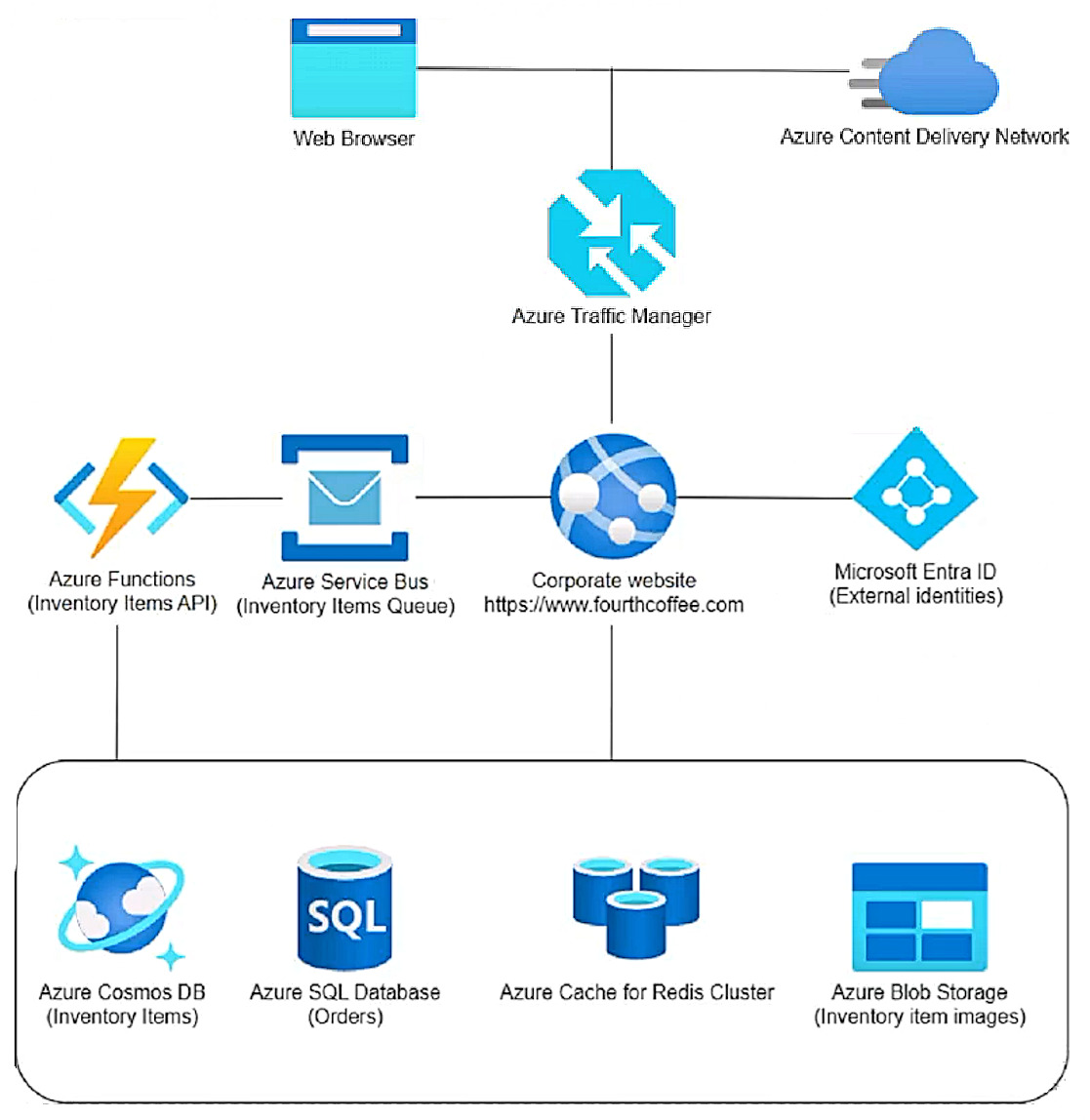
Requirements
-
The application components must meet the following requirements:
• Azure Cosmos DB development must use a native API that receives the latest updates and stores data in a document format.
• Costs must be minimized for all Azure services.
• Developers must test Azure Blob Storage integrations locally before deployment to Azure. Testing must support the latest versions of the Azure Storage APIs.
Corporate website
-
• User authentication and authorization must allow one-time passcode sign-in methods and social identity providers (Google or Facebook).
• Static web content must be stored closest to end users to reduce network latency.
Inventory items
-
• Customized items read from Azure Cosmos DB must maximize throughput while ensuring data is accurate for the current user on the website.
• Processing of inventory item updates must automatically scale and enable updates across an entire Azure Cosmos DB container.
• Inventory items must be processed in the order they were placed in the queue.
• Inventory item images must be stored as JPEG files in their native format to include exchangeable image file format (data) stored with the blob data upon upload of the image file.
• The Inventory Items API must securely access the Azure Cosmos DB data.
Orders
-
• Orders must receive inventory item changes automatically after inventory items are updated or saved.
Issues
-
• Developers are storing the Azure Cosmos DB credentials in an insecure clear text manner within the Inventory Items API code.
• Production Azure Cache for Redis maintenance has negatively affected application performance.
You need to implement code to process inventory changes and update orders.
Which configuration should you use? To answer, select the appropriate options in the answer area
NOTE: Each correct selection is worth one point.
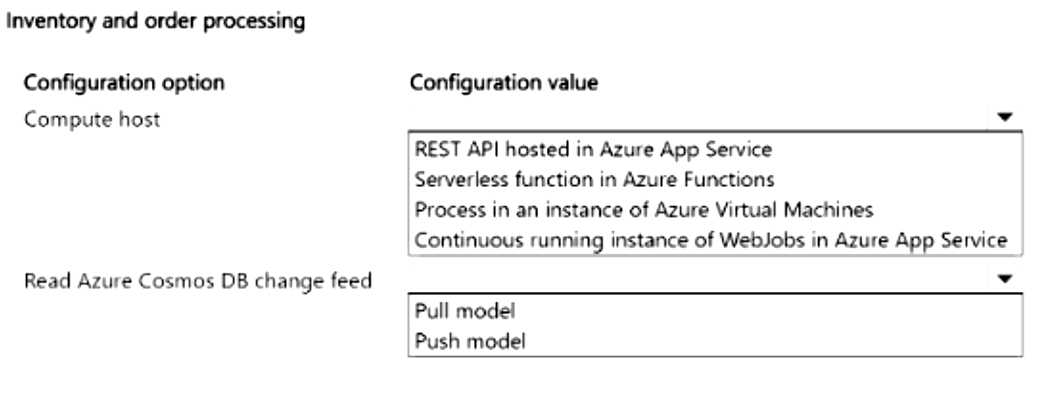
Correct Answer: 
A large retail company operates online and physical stores. The company tracks inventory levels in real time to manage stock efficiently across all locations. You develop an Azure Event Grid solution to handle events generated by the inventory management system deployed to Azure.
You need to implement a subscription filter that dynamically adjusts to seasonal changes in product demand.
Which event filter should you use?
A
An advanced filter using a Boolean condition that evaluates multiple data fields, including a season field within the event data
B
A prefix filter on the event type field that matches the current season's name
C
A subscription filter that uses label filter to include events tagged with seasonal promotional codes
D
A static subject filter that targets events with a subject ending in “/seasonal/inventory”
HOTSPOT -
You have an Azure Service Bus namespace that contains a topic named Topic1.
You plan to create a subscription named Sub1 to Topic1. In Sub1, you plan to filter messages from Topic1 based on their system properties and apply an action that will annotate each filtered message.
You need to configure the filtering.
How should you configure the filtering? To answer, select the appropriate options in the answer area.
NOTE: Each correct selection is worth one point.
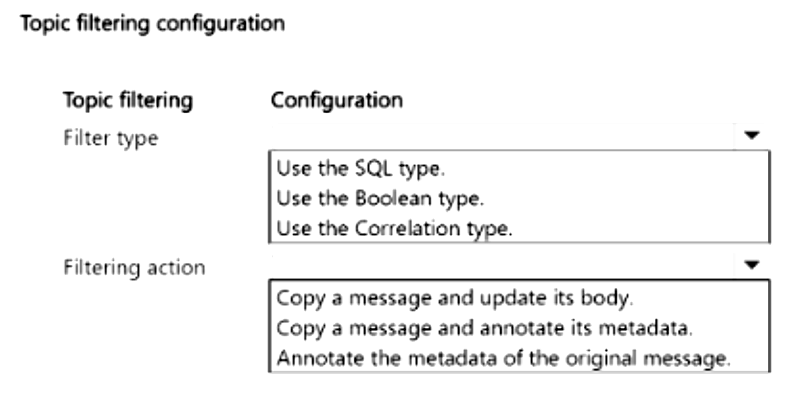
Correct Answer: 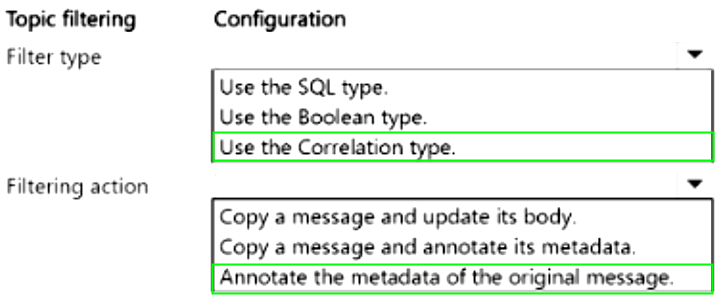
HOTSPOT
-
You have a Dockerfile that builds a container image named image1. The container image and its base image are stored in separate repositories of an Azure Container registry named registry1. The codebase of image1 is stored in a GitHub repo named app1 of an account named account1.
You plan to implement automatic updates to image1 whenever its base image is updated or an update to the main branch of the GitHub repo occurs.
You need to complete the Azure CLI command that will apply the planned implementation.
How should you complete the command? To answer, select the appropriate options in the answer area.
NOTE: Each correct selection is worth one point.
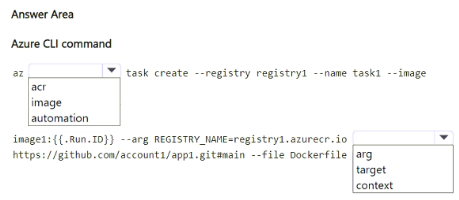
Correct Answer: 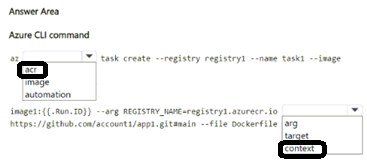
DRAG DROP
-
You manage an Azure Cosmos DB for a NoSQL API account named account1. You configure account1 with the default consistency level.
An application named app1 must access containers in account1 to perform read and write operations. The connections from app1 to account1 must be established by using the direct mode.
You plan to configure app1 to override the default consistency level by using the Azure Cosmos DB SDK client.
You need to set the maximum consistency level for app1 to use for read and write operations.
Which consistency level should you set? To answer, move the appropriate maximum consistency levels to the correct operation types. You may use each maximum consistency level once, more than once, or not at all. You may need to move the split bar between panes or scroll to view content.

Correct Answer: 
DRAG DROP
-
You manage an Azure subscription associated with a Microsoft Entra tenant named contoso.com. The subscription contains an Azure Blob Storage account named storage1. Your user account has the Contributor Azure role-based access control (RBAC) role within the scope of the subscription.
You plan to implement secure access to containers and blobs in storage1. Your solution must satisfy the following requirements:
• Authorization requests to access storage1 content must be authenticated by using Microsoft Entra credentials.
• Authorized access to storage1 content must be time-limited based on arbitrary values specified when requests are raised.
• The principle of least privilege must be satisfied.
You need to implement the plan.
Which three actions should you perform in sequence? To answer, move the appropriate secure access implementation options from the list of secure access implementations to the answer area and arrange them in the correct order.
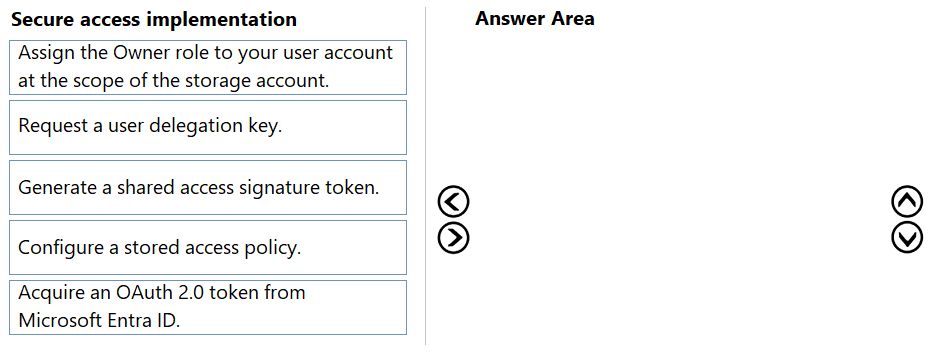
Correct Answer: 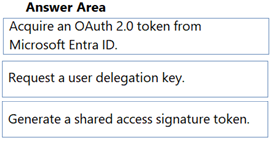
Case study -
This is a case study. Case studies are not timed separately. You can use as much exam time as you would like to complete each case. However, there may be additional case studies and sections on this exam. You must manage your time to ensure that you are able to complete all questions included on this exam in the time provided.
To answer the questions included in a case study, you will need to reference information that is provided in the case study. Case studies might contain exhibits and other resources that provide more information about the scenario that is described in the case study. Each question is independent of the other questions in this case study.
At the end of this case study, a review screen will appear. This screen allows you to review your answers and to make changes before you move to the next section of the exam. After you begin a new section, you cannot return to this section.
To start the case study -
To display the first question in this case study, click the Next button. Use the buttons in the left pane to explore the content of the case study before you answer the questions. Clicking these buttons displays information such as business requirements, existing environment, and problem statements. When you are ready to answer a question, click the Question button to return to the question.
Background -
Fourth Coffee is a global coffeehouse chain and coffee company recognized as one of the world’s most influential coffee brands. The company is renowned for its specialty coffee beverages, including a wide range of espresso-based drinks, teas, and other beverages. Fourth Coffee operates thousands of stores worldwide.
Current environment -
The company is developing cloud-native applications hosted in Azure.
Corporate website -
The company hosts a public website located at http://www.fourthcoffee.com/. The website is used to place orders as well as view and update inventory items.
Inventory items -
In addition to its core coffee offerings, Fourth Coffee recently expanded its menu to include inventory items such as lunch items, snacks, and merchandise. Corporate team members constantly update inventory. Users can customize items. Corporate team members configure inventory items and associated images on the website.
Orders -
Associates in the store serve customized beverages and items to customers. Orders are placed on the website for pickup.
The application components process data as follows:
1. Azure Traffic Manager routes a user order request to the corporate website hosted in Azure App Service.
2. Azure Content Delivery Network serves static images and content to the user.
3. The user signs in to the application through a Microsoft Entra ID for customers tenant.
4. Users search for items and place an order on the website as item images are pulled from Azure Blob Storage.
5. Item customizations are placed in an Azure Service Bus queue message.
6. Azure Functions processes item customizations and saves the customized items to Azure Cosmos DB.
7. The website saves order details to Azure SQL Database.
8. SQL Database query results are cached in Azure Cache for Redis to improve performance.
The application consists of the following Azure services:
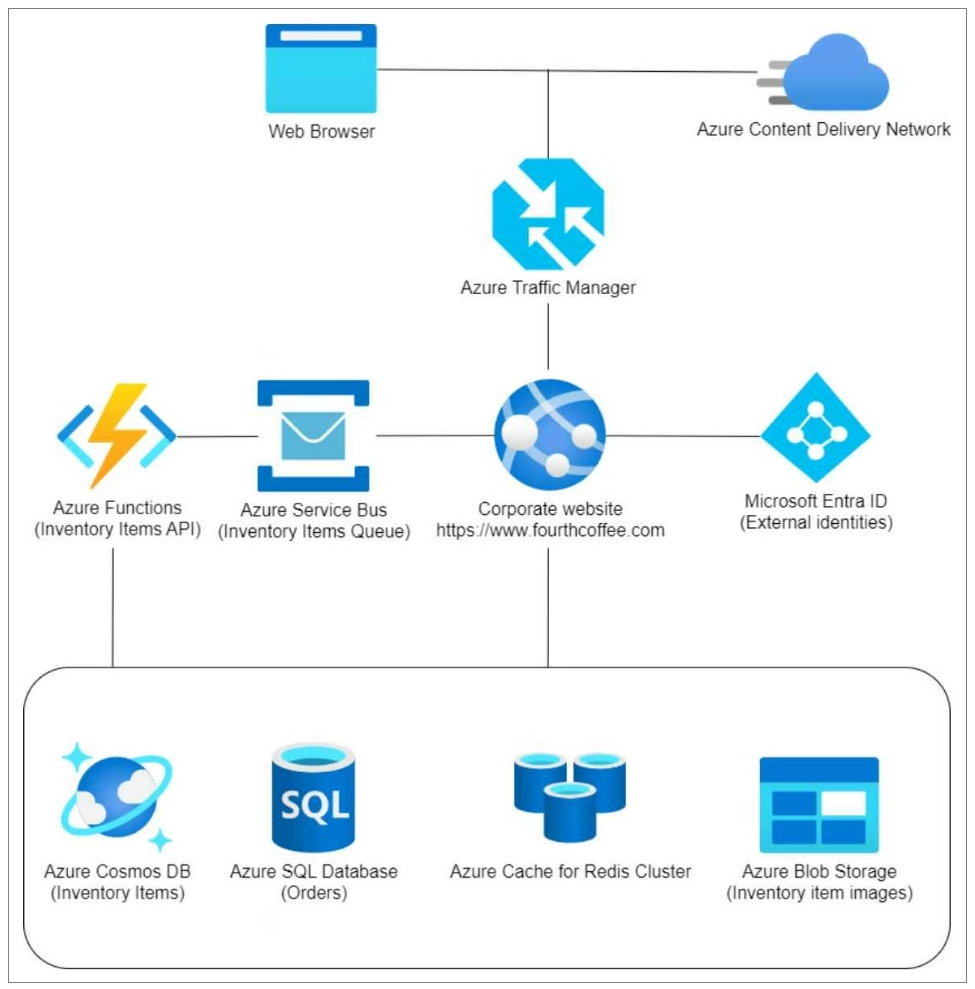
Requirements -
The application components must meet the following requirements:
• Azure Cosmos DB development must use a native API that receives the latest updates and stores data in a document format.
• Costs must be minimized for all Azure services.
• Developers must test Azure Blob Storage integrations locally before deployment to Azure. Testing must support the latest versions of the Azure Storage APIs.
Corporate website -
• User authentication and authorization must allow one-time passcode sign-in methods and social identity providers (Google or Facebook).
• Static web content must be stored closest to end users to reduce network latency.
Inventory items -
• Customized items read from Azure Cosmos DB must maximize throughput while ensuring data is accurate for the current user on the website.
• Processing of inventory item updates must automatically scale and enable updates across an entire Azure Cosmos DB container.
• Inventory items must be processed in the order they were placed in the queue.
• Inventory item images must be stored as JPEG files in their native format to include exchangeable image file format (data) stored with the blob data upon upload of the image file.
• The Inventory Items API must securely access the Azure Cosmos DB data.
Orders -
• Orders must receive inventory item changes automatically after inventory items are updated or saved.
Issues -
• Developers are storing the Azure Cosmos DB credentials in an insecure clear text manner within the Inventory Items API code.
• Production Azure Cache for Redis maintenance has negatively affected application performance.
You need to support local development testing for developers.
Which tool should you use?
A
Azurite
B
Azure Storage Emulator
C
SQL Server Management Studio (SSMS)
D
Azure Storage Explorer
HOTSPOT
-
You have an Azure Blob Storage account named account1.
You plan to grant permissions for access to blobs in account1 by using a combination of a shared access signature token and a stored access policy. You must set the duration of the token validity by using the stored access policy.
You need to complete the configuration of the stored access policy and generate the shared access signature token.
Which token setting and token type should you use? To answer, select the appropriate options in the answer area.
NOTE: Each correct selection is worth one point.
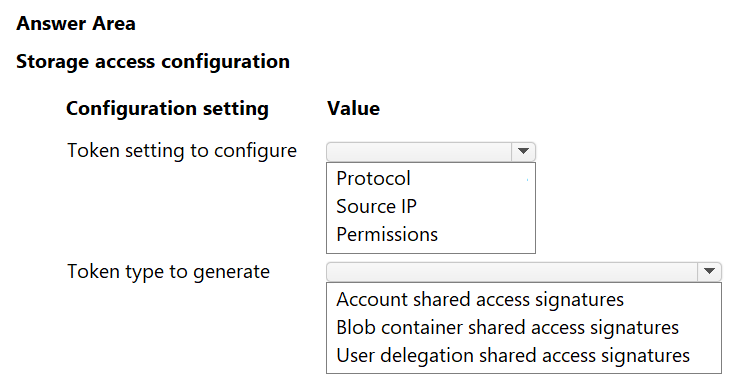
Correct Answer: 
You have 100 Azure virtual machines (VMs) with the system-assigned managed identity enabled.
You need to identify the value of the object ID attribute for each of the identities.
Which command should you use?
A
az ad sp credential list
B
Get-AzVM
C
Get-AzureADUser
D
az resource show
You have 100 Azure virtual machines (VMs) with the system-assigned managed identity enabled.
You need to identify the value of the object ID attribute for each of the identities.
Which command should you use?
A
Get-AzureADUser
B
Get-AzResource
C
Get-AzureADUserOwnedObject
D
az ad signed-in-user list-owned-objects
HOTSPOT
-
You are developing a web application that makes calls to the Microsoft Graph API. You register the application in the Azure portal and upload a valid X509 certificate.
You create an appsettings.json file containing the certificate name, client identifier for the application, and the tenant identifier of the Microsoft Entra ID. You create a method named ReadCertificate to return the X509 certificate by name.
You need to implement code that acquires a token by using the certificate.
How should you complete the code segment? To answer, select the appropriate options in the answer area.
NOTE: Each correct selection is worth one point.
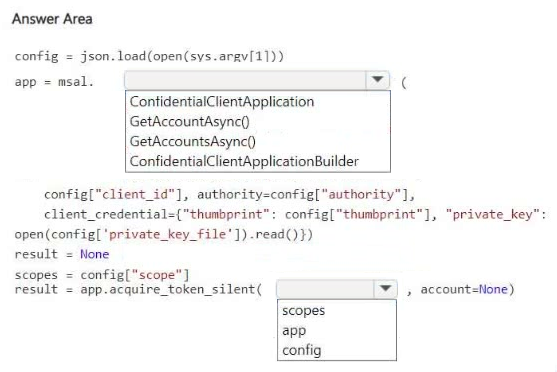
Correct Answer: 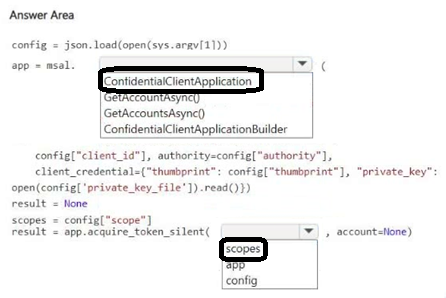
Question #450
You develop applications that integrate with a Microsoft Entra tenant.
You plan to implement a permission classification in the tenant.
You need to select permissions to include in your classification.
Which permissions should you select?
A
app-only access permissions that require admin consent
B
delegated permissions that require only user consent
C
app-only access permissions that require only user consent
D
delegated permissions that require admin consent
